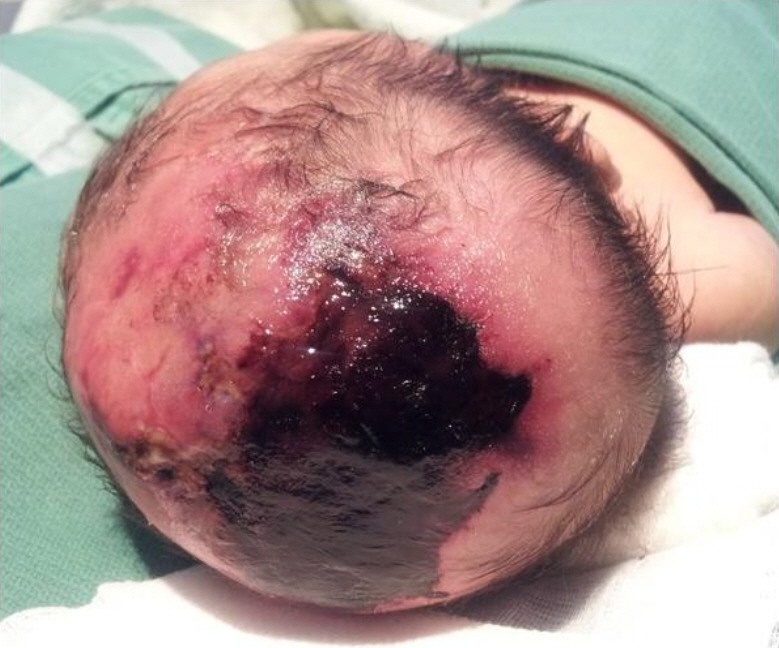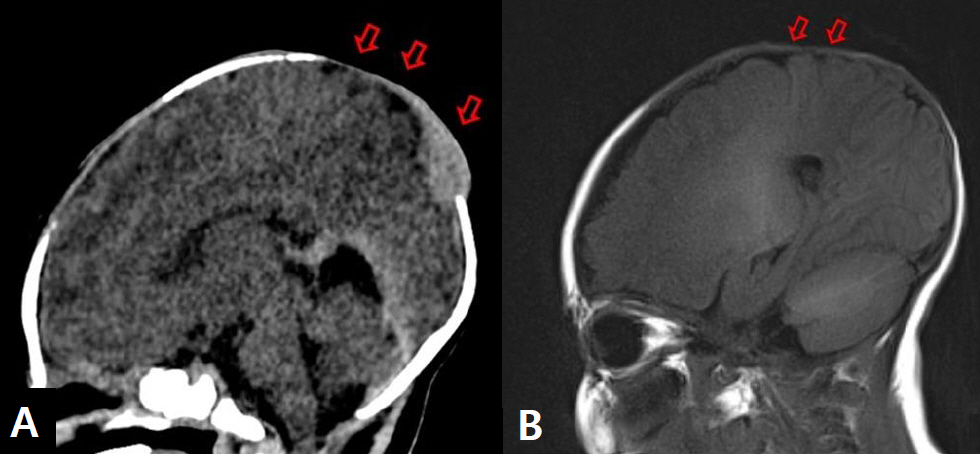Neonatal Med.
2021 Feb;28(1):48-52. 10.5385/nm.2021.28.1.48.
Case of Mental Retardation Associated with Aplasia Cutis Congenita and Skull Defect
- Affiliations
-
- 1Department of Pediatrics, Inje University Ilsan Paik Hospital, Inje University College of Medicine, Goyang, Korea
- KMID: 2513359
- DOI: http://doi.org/10.5385/nm.2021.28.1.48
Abstract
- Aplasia cutis congenita (ACC) is a rare congenital disorder characterized by skin defects involving the epidermis, dermis, subcutaneous tissue, bone, and sometimes dura. It commonly affects the scalp in approximately 70% of cases, but the neck, trunk, and the extremities can also be affected. ACC can occur either as an isolated condition or associated with other anomalies and congenital syndromes, and it can be acquired either genetically or sporadically. Morbidity and mortality are associated with the defects of skull bone, dura, and other multiple anomalies. We herein report the case of a female infant, with a large scalp defect accompanied by a skull defect noted at birth, who developed mental retardation in the preschool years.
Keyword
Figure
Reference
-
1. Browning JC. Aplasia cutis congenita: approach to evaluation and management. Dermatol Ther. 2013; 26:439–44.2. Bharti G, Groves L, David LR, Sanger C, Argenta LC. Aplasia cutis congenita: clinical management of a rare congenital anomaly. J Craniofac Surg. 2011; 22:159–65.3. Smartt JM Jr, Kim EM, Tobias AM, Yan AC, Kirschner RE. Aplasia cutis congenita with calvarial defects: a simplified management strategy using acellular dermal matrix. Plast Reconstr Surg. 2008; 121:1224–9.4. Frieden IJ. Aplasia cutis congenita: a clinical review and proposal for classification. J Am Acad Dermatol. 1986; 14:646–60.5. Chitnis MR, Carachi R, Galea P. Familial aplasia cutis congenita. Eur J Pediatr Surg. 1996; 6:100–1.6. Demmel U. Clinical aspects of congenital skin defects. I. Congenital skin defects on the head of the newborn. Eur J Pediatr. 1975; 121:21–50.7. Humphrey SR, Hu X, Adamson K, Schaus A, Jensen JN, Drolet B. A practical approach to the evaluation and treatment of an infant with aplasia cutis congenita. J Perinatol. 2018; 38:110–7.8. Stephan MJ, Smith DW, Ponzi JW, Alden ER. Origin of scalp vertex aplasia cutis. J Pediatr. 1982; 101:850–3.9. Basterzi Y, Bagdatoglu C, Sari A, Demirkan F. Aplasia cutis congenita of the scalp and calvarium: conservative wound management with novel wound dressing materials. J Craniofac Surg. 2007; 18:427–9.10. Santos de Oliveira R, Barros Juca CE, Lopes Lins-Neto A, Aparecida do Carmo Rego M, Farina J, Machado HR. Aplasia cutis congenita of the scalp: is there a better treatment strategy? Childs Nerv Syst. 2006; 22:1072–9.11. Silberstein E, Pagkalos VA, Landau D, Berezovsky AB, Krieger Y, Shoham Y, et al. Aplasia cutis congenita: clinical management and a new classification system. Plast Reconstr Surg. 2014; 134:766e–74e.12. Lassman LP, Sims DG. Congenital midline scalp and skull defect. Arch Dis Child. 1975; 50:958–60.13. Ruiz-Maldonado R, Tamayo L. Aplasia cutis congenita, spastic paralysis, and mental retardation. Am J Dis Child. 1974; 128:699–701.14. Canter HI, Vargel I, Nasir S, Kayikcioglu A. Use of a water-vapour permeable polyurethane film (omiderm) in the non-surgical treatment of aplasia cutis congenita. Scand J Plast Reconstr Surg Hand Surg. 2004; 38:232–5.15. Azad S, Falder S, Harrison J, Graham K. An adherent dressing for aplasia cutis congenita. Br J Plast Surg. 2005; 58:1159–61.16. Maillet-Declerck M, Vinchon M, Guerreschi P, Pasquesoone L, Dhellemmes P, Duquennoy-Martinot V, et al. Aplasia cutis congenita: review of 29 cases and proposal of a therapeutic strategy. Eur J Pediatr Surg. 2013; 23:89–93.17. Harvey G, Solanki NS, Anderson PJ, Carney B, Snell BJ. Management of aplasia cutis congenita of the scalp. J Craniofac Surg. 2012; 23:1662–4.18. Rhee ST, Colville C, Buchman SR, Muraszko K. Complete osseous regeneration of a large skull defect in a patient with cutis aplasia: a conservative approach. J Craniofac Surg. 2002; 13:497–500.19. Schneider BM, Berg RA, Kaplan AM. Aplasia cutis congenita complicated by sagittal sinus hemorrhage. Pediatrics. 1980; 66:948–50.




